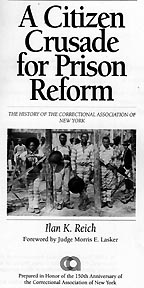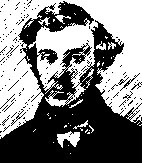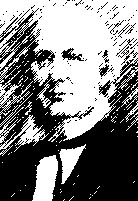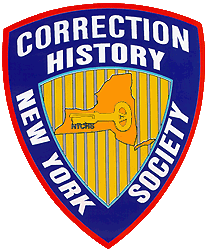
Acknowledgments
This book is based largely on the archives of the
Correctional Association.
For fifteen decades, concerned citizens laboring to
create a more just and humane criminal justice system have fastidiously
preserved records documenting the challenges, obstacles, and accomplishments of
the Association toward that goal. . . .
Numerous present-day officers and board members . . . deserve recognition for their vision, insight, and criticism, which helped bring this project to fruition, including
Ralph S. Brown, Jr., William J. Dean, Carol Bernstein Ferry, Robert Gangi, Clay
Hiles, Michael B. Mushlin, and Elizabeth Osborne. Thanks also to Anthony J.
Scanlon, who initiated this project . . . .
The publication of this book was made possible by the
generous contribution of Western Publishing Group, Inc., which donated its
editorial, design, and printing services. . . .Richard A. Bernstein, chairman and chief
executive officer of Western Publishing Group, Inc., deserves special commendation . . . My special thanks go to Frederick A. 0. Schwarz, Jr., for
setting an example with his longtime devotion to public and community service . . . .
Ilan K. Reich
New York, NY
|
INTRODUCTION
The year 1844: Queen Victoria marks her seventh year on the
throne of England; John Tyler, a Southerner who supported slavery, is the tenth
President of the United States; Congress debates the annexation of Texas and
the acquisition of Oregon from British interests controlled by the Hudson's Bay
Company; Samuel Morse patents the telegraph; Elias Howe is completing his
invention of the sewing machine; New. York City's population reaches 300,000;
and, on December 6, sixty-one gentlemen call on the public to form a
voluntary society known as the Prison Association of New York.
The leading organizer of the effort to form the Association
was John W. Edmonds, a New York State Supreme Court justice . . . Judge Edmonds was the circuit judge in a branch of the court known as the Oyer and Terminer, where "he presided at many criminal trials ... and it occurred to him that in the exercise of this discretion [to sentence
criminals], he ought to be more fully informed than he was as to the manner in
which prisoners were confined, the discipline to which [they were] subjected
[so] that he might discriminate more justly in fixing the period of incarceration,
and especially in reference to the possibility or probability of the future
reformation of the criminals."
Accordingly, he made several visits to Sing
Sing Prison, and found the existing system -- if it could be called that
--- very defective; in fact, so much so, as to require a reformation so
extensive he thought it could not be brought about by the efforts, however
earnest or active, of any one individual; but required a permanent body charged
with this humane and useful work.
|
Foreword
This remarkable volume chronicles and celebrates the worthy
history of the Correctional Association of New York upon the occasion of its
150th anniversary. . . .
The determination of how a society should deal with persons
who violate its rules and customs presents a dilemma. It is a dilemma because
of the conflict inherent in deciding whether the emphasis in the treatment of
criminals should be upon punishment and sequestration of the offender in
the hope of deterring him and others from committing further offenses or,
on the other hand, redeeming the prodigal son so that, with a new set of
values, he will internalize conformity with society's rules.
One hundred fifty years ago Pennsylvania and New York pioneer
reformers opted for the creation of institutions of confinement that would
cure the criminal by a ritual of atonement. . . .The prison, an institution
conceived in the early nineteenth century as an enlightened cure-all that
would not only substitute for the cruel physical punishment of the past ---
such as execution, amputation, and flogging --- but rehabilitate the prisoner,
teaching him virtue, seemed simple in concept but nevertheless a panacea. It
has not worked that way.
Today over one hundred thousand people are confined in correctional
facilities in New York State. There are more than one and a half million
prisoners in the entire United States . . . .
In light of the magnitude and complexity of the problem
crime and the efforts to eliminate crime in today's society, good fortune for
New York that the Correctional Association survived and thrived and continues
to tell it like it is, to educate the public, to ensure that officeholders face
the truth, and to protect the rights and legitimate interests of prisoners.
Judge Morris E. Lasker
United States District Court for the
Southern District of New York
|
The Call to Action
The public notice that appeared in New York City newspapers
calling upon concerned citizens to attend a meeting to form the Association
pleaded for the need to "find employment for those [released prisoners]
who shall give evidence of repentance and reformation." The first meeting
of the Association was held at the Apollo Rooms, 410 Broadway, in New York
City. "Despite the inclement weather," reported the New York Tribune
the next day, "a large and highly intelligent audience assembled to act in
the work of reforming prisoners and of adjusting our very imperfect and in some
respects inhuman system of prison discipline." This outcry for public
action observed that a discharged convict was entitled by law to receive
"the mere pittance of three dollars" from the warden and maybe, if he
was lucky, the return of his clothing and other possessions that were
surrendered when he entered prison.
The Association noted that despite a state statute mandating
the return of a prisoner's personal articles after the term of confinement,
"not only is his clothing treated as a forfeiture to the State as well as
his liberty, but even mementos of affection ... are sometimes cast aside or
destroyed with a want of feeling not particularly commendable in the
administration of justice. John Edmonds commented: "When they go forth
into the world, they are often, for want of employment, reduced to great distress
and subjected to sore temptations. To starve or steal, is too often the only
alternative presented to them."
It was not uncommon for discharged prisoners to lack
"money enough even to pay their stage fare down to the city, and when they
arrive among us, unless they have friends who can relieve them, or can find
some one kind enough to trust them with the means of living, or the means of
earning it, they must of necessity starve or steal. Why should we wonder that
they find their way back again to prison, and that right speedily?"
|
In 1844 a discharged convict was entitled by law to receive
"the mere pittance of three dollars" from the warden and maybe, if he
was lucky, the return of his clothing and other possessions that were
surrendered when he entered prison.
|
The problem was compounded in 1845, when the Legislature "enlarged that [$3] pittance by adding to it three cents a mile, for the distance from the prison to the place of trial. But, by an erroneous construction of the statute ... this allowance of mileage [became] a
substitute for, not an addition to, the former allowance of $3." In one instance a man who wished to return to his family in Ohio upon his discharge from Auburn Prison received
three cents.
More than a century later this issue still persisted. In
1959 the Association deplored the practice of giving twenty-five cents to
inmates discharged from Rikers and Hart islands. "Despite all the efforts
made toward rehabilitation while in custody the fact remains that many of these
prisoners need assistance on release, especially at a time when a telephone
call or a subway ride consumes all, or a major portion, of the paltry
allowance of twenty-five cents.”
|
Only five of the sixty-seven female inmates at Sing
Sing Prison in 1846 could read or write with any proficiency. Their educational
program consisted of a half hour of reading each morning from "Mr.
Sargent’s admirable temperance Tales [which are] exactly adapted to their
necessities, and their sad experience."
|
The Association's remedial efforts were aimed at prisoners
of both sexes, even though in the 1840s the number of female prisoners was
small. In 1846 at Sing Sing Prison there were 67 female inmates (as compared to
737 males); about one-half had been committed to the prison that year.
Nearly all were serving sentences of two to four years, although five women
were serving ten-year sentences. Virtually all of the female prisoners had
committed crimes "against property;" two female prisoners under age,
twenty were serving their second sentence at Sing Sing. To help these members
of the prison population, the Association formed a Female Department,
"consisting of such females as shall take an interest in the objects of
the Society ... and have particularly in their charge the interests and welfare
of prisoners of their sex."
|
Each year the Association has printed an annual report for transmittal to the NYS Legislature, as contemplated by the 1846 law granting the Association its charter. . . The oldest prison reform organization in the U.S. is the Pennsylvania Prison Society, founded in 1787. It was originally known as the Philadelphia Society for Alleviating the Miseries of Public Prisons. . . .
|
The problems of female prisoners were acute. Only five of
the female inmates at Sing Sing Prison in 1846 could read or write with any
proficiency, while the educational program in prison consisted of a half hour
of reading each morning from "Mr. Sargent's admirable temperance Tales
[which are] exactly adapted to their necessities, and their sad
experience." At the city prison on Blackwells Island, "the prisoners
of both sexes ... were under one roof, in different tiers of cells, under the
sole charge of men, and daily exposed to gross improprieties."
The Association's Mission
At the time of the Association's formation in 1844 its
constitution embraced three basic purposes:
|
The Association officially changed its name to the Correctional Association of New York on March 1, 1961.
|
- the amelioration of the condition of prisoners whether
detained for trial, or finally convicted, or as witnesses;
the improvement of Prison Discipline and the Government of
Prisons; and
the support and encouragement of reformed convicts after
their discharge, by affording them the means of obtaining an honest livelihood,
and sustaining them in their efforts at reform.

In a letter to the Association dated September 28, 1846,
Alexis de Tocqueville "urgently request[ed] you to send me all that shall
be published in America, during the ensuing year, on the important subject of
prisons." He had traveled to the U.S. to study the Separate and
Silent systems and recognized one for France. His choice was the Silent System.
|
The by-laws adopted by the Association greatly
amplified this basic mission. Rather than simply aid discharged convicts in
obtaining employment, the founding members endeavored to establish a
multifaceted, voluntary public service and civic organization. In today's
vernacular, the Association was nothing less than a legal aid society, a think
tank on emerging theories of prison reform, a special committee with plenary
powers to investigate prison conditions, a social services agency ministering
to the needs of inmates' families, a halfway house for released inmates, and a
lobbying firm seeking to influence the direction of prison legislation, all
rolled into a single organization . . .
Looking at society's attitudes [in 1844] toward prisoners and criminals (the two are not always the same), one finds a barbaric and brutal
world with only the smallest pinholes of enlightenment and concern for basic
human dignity and fundamental civil rights. It was not unusual for a prison to
house together debtors, persons awaiting trial, convicts with sentences of
less than six months, and witnesses "until the trials at which they may be
wanted."
The Association was certainly among the more enlightened
citizen groups of the time." Its membership included many prominent
figures from New York society and abroad. In fact, for many years Oscar 1, the
King of Sweden and Norway, was an honorary member; Alexis de Tocqueville and
John Stuart Mill were corresponding members.

In its first year the Association raised nearly $2, 000 in
cash contributions, as well as donations of goods such as fish, brooms, dried
apples, combs, and a subscription to the Tribune from Mr. Horace Greeley, its
publisher.
|
From its inception, the Association's efforts were
nonpartisan and entirely voluntary, and its funding came solely from private
contributions. Article VII of the Association's constitution specifies that a
$25 contribution "shall constitute a member of the Association for
life;" $100 would make one "an honorary member of the Executive
Committee for life;" and a $500 contribution "Shall constitute a life
Patron." In its first year the Association raised nearly $2,000 in cash
contributions, as well as donations of goods such as fish, brooms, dried apples,
combs, and a subscription to the Tribune from Mr. Horace Greeley, its
publisher.
Predictably, the Association's ambitious and wide-ranging
mission quickly surpassed the generosity of its supporters. Not to be
deterred, much of the Association's pioneering work in investigating abuses
and the brutal conditions in prisons was funded from Executive Committee
members' own pockets rather than the Association's budget. In its early years,
when visits were largely confined to the prisons in New York City and the three
state prisons, the Association's members undertook that labor without any
remuneration. By contrast, in 1867 when the Association visited virtually every
prison and jail in New York State (more than sixty), the cost was nearly $7,000
and constituted more than one-half of that year's budget.
|




